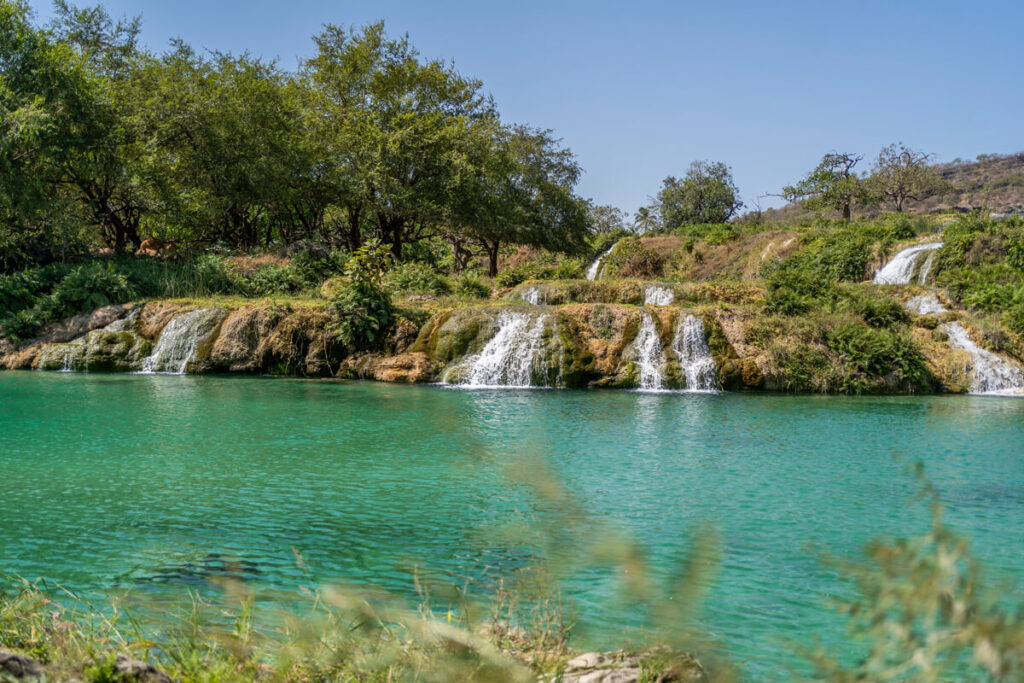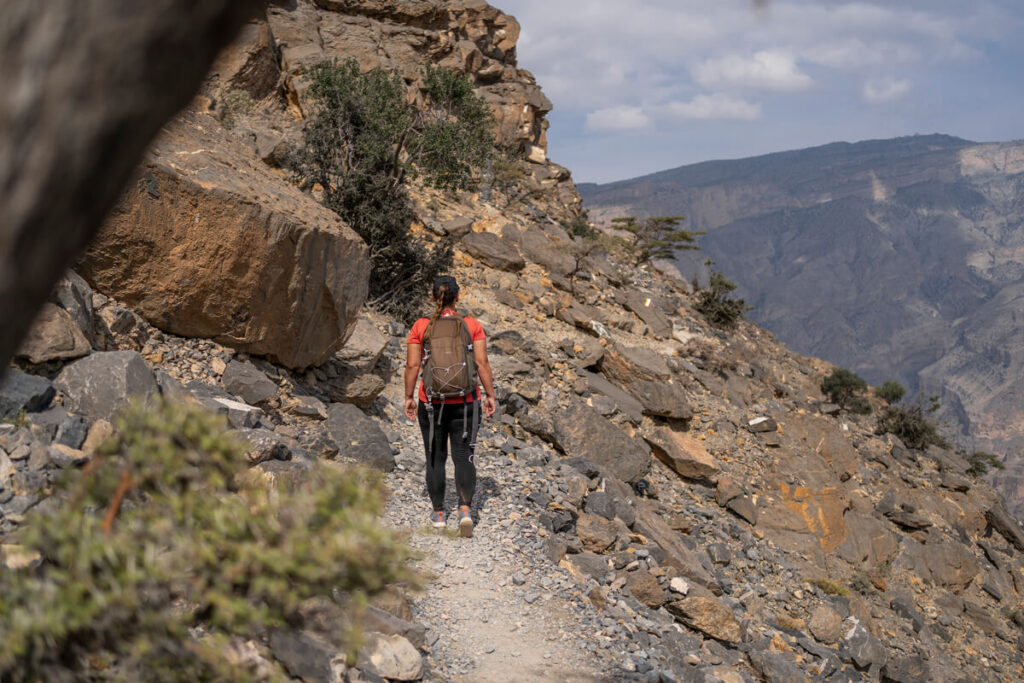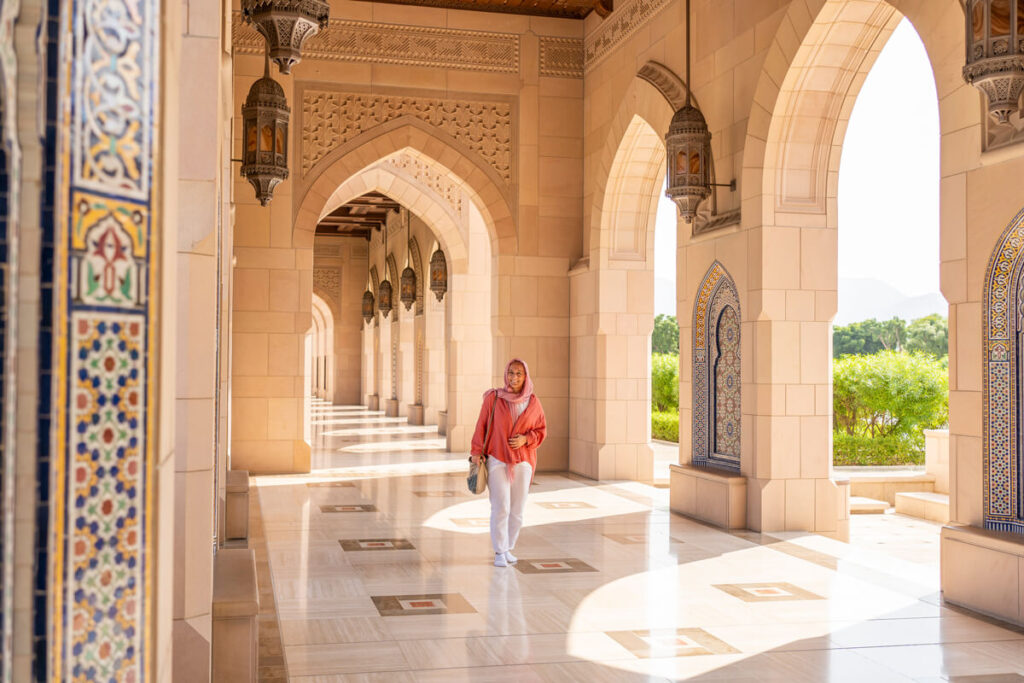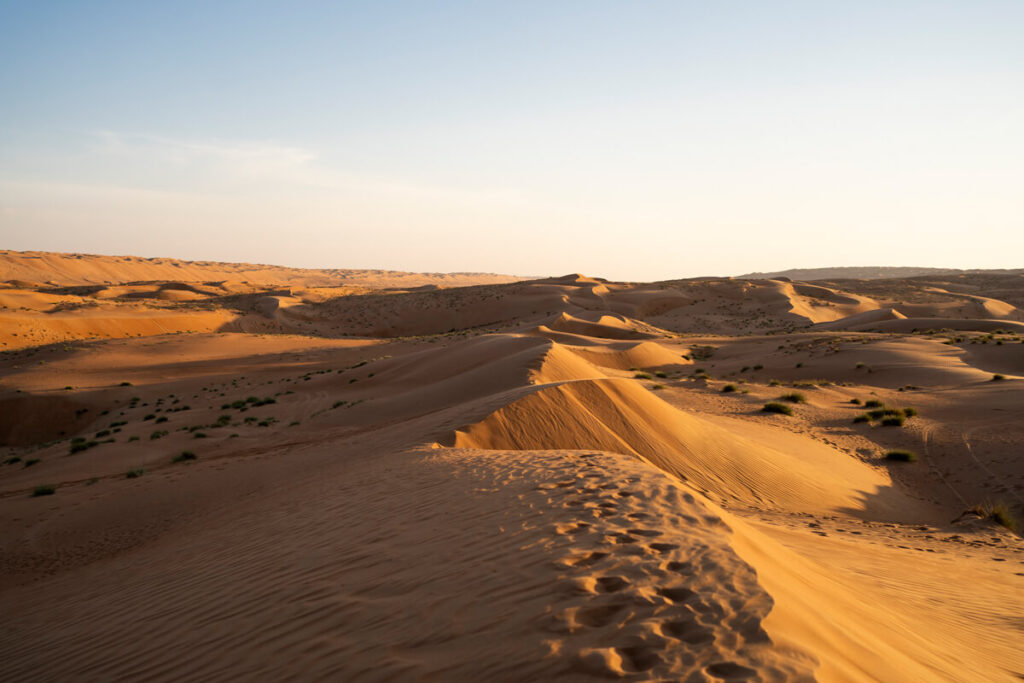You want to travel to Oman and are wondering when the best time to travel to Oman is? The answer to this question depends on various factors. The country is located on the Arabian Peninsula and has a mostly dry and hot climate.
While you can expect extreme heat in the summer months (May – September), the winter months (October to March) are much more pleasant and therefore best suited for a trip to Oman. In the following article, we’ll tell you everything about the climate in Oman, the best time to travel, and also about the rainy season. Enjoy browsing!
- When is the best time for Oman?
- Winter (November to February):
- Spring (March to April):
- Summer (May to September):
- What is the climate like in Oman?
- When is the rainy season in Oman?
- Climate table for Oman (Muscat)
- What are the water temperatures in Oman?
- Best time to travel to Oman by activity
- Best time to travel for hiking in Oman
- Best time to travel for swimming in Oman
- Best time to travel for sightseeing in Oman
- Best time to travel for the desert in Oman
- Traveling to Oman during Ramadan?
- All information about Ramadan at a glance Overview
- Best Time to Travel to Oman – Our Conclusion
When is the best time to visit Oman?
The best time to travel to Oman depends on your individual preferences and planned activities. The climate can generally be divided into three main periods: winter, spring, and summer. Europeans prefer to travel to Oman between October and March, as temperatures are pleasantly mild, especially in the coastal areas.
Residents of the surrounding countries on the Arabian Peninsula prefer to travel to Oman during the monsoon season (Khareef season) to escape the heat at home and enjoy the humid, rainy weather. Yes, you heard right. They love the rain in Oman!
Winter (November to February):
Winter is the most popular time to visit Oman because of the pleasantly mild temperatures, especially along the coast. Daytime temperatures typically range between 20°C and 30°C, while it gets a bit cooler at night. This time of year is also good for outdoor activities in the mountains and desert, as well as sightseeing in the cities and mountain villages.
Spring (March to April):
Temperatures gradually rise in spring but can still be quite pleasant. There are fewer tourists than in the winter months, making the attractions more relaxing. This time is also good for hiking in the mountains.
Summer (May to September):
Summer in Oman can be very hot, especially in the desert areas. Daytime temperatures can easily rise above 40°C, and there is very little to no rain. This time of year is less suitable for outdoor activities unless you prefer extreme heat and plan activities in the cooler morning or evening hours.
What is the climate like in Oman?
The climate in Oman is mostly dry and hot, as the country is mostly desert. However, there are also coastal areas and the Hajar Mountains that influence the climate. Generally, the climate in Oman can be divided into three main types: coastal climate, mountain climate, and desert climate.
Coastal climate: The coastal regions, especially along the Arabian Gulf and the Gulf of Oman, have a hot desert climate. The summer months, from May to September, are very hot, with average temperatures above 40°C. Winters, however, are considerably milder, with temperatures between 20°C and 30°C.
Mountain climate: The Hajar Mountains (elevations of over 3,000 m), which extend through the northeast of the country, influence the climate at higher altitudes. Summers here are somewhat milder than in the coastal regions, while winters can be cooler, with temperatures around 10°C or below.
Desert climate: Most of the country is desert, particularly the Wahiba Sands and the Rub al Khali in the south. Temperatures here can be extreme, especially in summer, with temperatures often exceeding 50°C. The recommended months are between October and March.
Rainfall in Oman is generally low, especially in the desert areas. However, the coastal areas can experience slightly more rainfall during the summer monsoon season. The best time to visit Oman to avoid the extreme summer heat is during the winter and spring months, when temperatures are milder.
When is the rainy season in Oman?
Oman has two rainy seasons, although the country has a predominantly arid to semi-arid climate. The more noticeable rainy season falls in the summer, particularly between June and September. During this time, the monsoon from the Indian Ocean brings rain, especially to the Dhofar region around Salalah – also known as the “Khareef season.”
The rain not only provides cooling but also transforms the landscape into a green oasis. The flowering hills and more pleasant climate attract both locals and tourists from neighboring countries seeking to escape the summer heat. In the rest of the country, humidity increases during these months, but rain is significantly less frequent.

The second rainy season falls during the winter months, primarily from January to March. During this time, there are occasional showers that enliven the landscape, adding a splash of green to the otherwise dry desert landscape. However, these winter rains are significantly less frequent and less intense than the monsoon rains in summer.
Despite the two rainy seasons, Oman remains a very dry country, with many regions experiencing hardly any rainfall year-round. However, the rainy seasons, whether in summer or winter, provide exciting contrasts and showcase the country’s scenic diversity.
Climate table for Oman (Muscat)
This table for Muscat is intended as a general reference. We recommend checking the current weather forecasts before your trip so you can better prepare for your trip. We were in Oman for 17 days at the beginning of November and averaged 30°C – 32°C daily. The water temperature was 26°C. It didn’t rain during this time.
What are the water temperatures like in Oman?

In the summer months (May to September), water temperatures in Oman reach their peak and are often 30°C or more, especially in shallow coastal waters. This is no longer a real cooling-off point. Even in autumn (October), the water remains pleasantly warm at 25°C to 30°C.
Of course, these are average values, and local conditions, ocean currents, or geographical location can influence temperatures. During our November tour, we had water temperatures of at least 26°C almost everywhere – perfect for swimming!
Best time to visit Oman by activity
Best time to hike in Oman
The best months for hiking in Oman are winter and spring, when temperatures are pleasant. In winter, daytime temperatures usually range between 20°C and 25°C, while it can get cooler at night. Especially in the mountains, the clear air and milder heat are ideal for longer tours through wadis or mountainous landscapes.
In spring, temperatures rise slowly but remain pleasant for hikes, especially in the mountains. Nature is at its most beautiful during this time, and since there are fewer tourists, the hiking trails are often quieter.
The summer months (May to September) are less suitable for hiking due to the extreme heat, especially in desert regions. If you want to go hiking, the cooler months are definitely the better choice – not only for comfort, but also for safety reasons.

Best time to go swimming in Oman
A beach holiday in Oman is basically possible all year round. However, the best months for it are winter and spring. In winter, the water temperature is a pleasant 20°C to 25°C – perfect for swimming and relaxing.
In spring (March to April), the sea warms up as the outside temperature rises, reaching temperatures of 25°C to 30°C, ideal for beach days and water sports.
In summer (May to September), the water can get very warm, especially in shallow coastal areas – almost too warm for refreshment. A highlight from June to October: With a little luck, you might spot whale sharks during this time!
Best time to travel for sightseeing in Oman

In spring, temperatures slowly continue to climb, and nature is in full bloom. This time of year is ideal for sightseeing and cultural excursions, as it is not yet as hot as in summer. In the summer months, temperatures can easily rise above 40°C, which is rather unfavorable for extended explorations.
Best time to visit the desert in Oman
For desert adventures, the months from October to March are best, as temperatures during this time are pleasantly mild and far from the summer temperatures above 40°C. Humidity in the desert is very low year-round, which makes temperatures, whether warm or cool, usually feel more pleasant. January is considered the coldest month, with an average of around 24°C.

Traveling to Oman during Ramadan?
You can, of course, travel to Oman during Ramadan, but you will need to put a little more time into planning. During this holy fasting period, many Muslims do not eat or drink from sunrise to sunset. Therefore, you should be careful not to eat, drink, or smoke in public to respect the culture.
Many shops, restaurants, and public facilities have modified opening hours during Ramadan. Museums are often only open in the morning, and some places don’t open until after Iftar, the evening fast-breaking meal. Check in advance whether your planned activities are taking place, as desert regions and smaller towns can be quieter during the day.

Ramadan brings a special, festive atmosphere in the evening. At sunset, locals gather for Iftar, the communal celebration of fasting. There are special Iftar meals everywhere, and nighttime markets often offer a unique cultural experience. During this time, it is important to be culturally sensitive and to respect people’s religious traditions and practices.
All information about Ramadan at a glance
- Ramadan: Beginning of March to beginning of April
- Restaurants usually only open after sunset
- Avoid public eating and drinking between sunrise and sunset. Sunset
- If you are alone, you can of course eat and drink
- Hotels serve breakfast, lunch, and dinner despite Ramadan
- There are usually dining rooms/restaurant areas for non-Muslims to eat during the day
- Muslims have shorter working days during Ramadan
- Shops have different opening hours
- Supermarkets are open all day
- Hotel prices are often cheaper during Ramadan
- Locals meet at sunset to break their fast together
- Social life shifts to the evening hours
- There are fewer tourists during Ramadan
Best time to travel to Oman – Our conclusion
The best time to travel to Oman depends entirely on what you plan to do and what temperatures you prefer. The months from October/November to February, as well as spring in March and April, offer ideal conditions. During this time, it’s pleasantly mild—perfect for sightseeing, outdoor activities, and relaxing days at the beach.
You should avoid the hot summer months from May to September, as it can get extremely hot in many parts of the country. If you travel during Ramadan, remember to respect local customs, as religious and cultural traditions are especially important during this time. Whenever you travel, we wish you an unforgettable time in Oman!